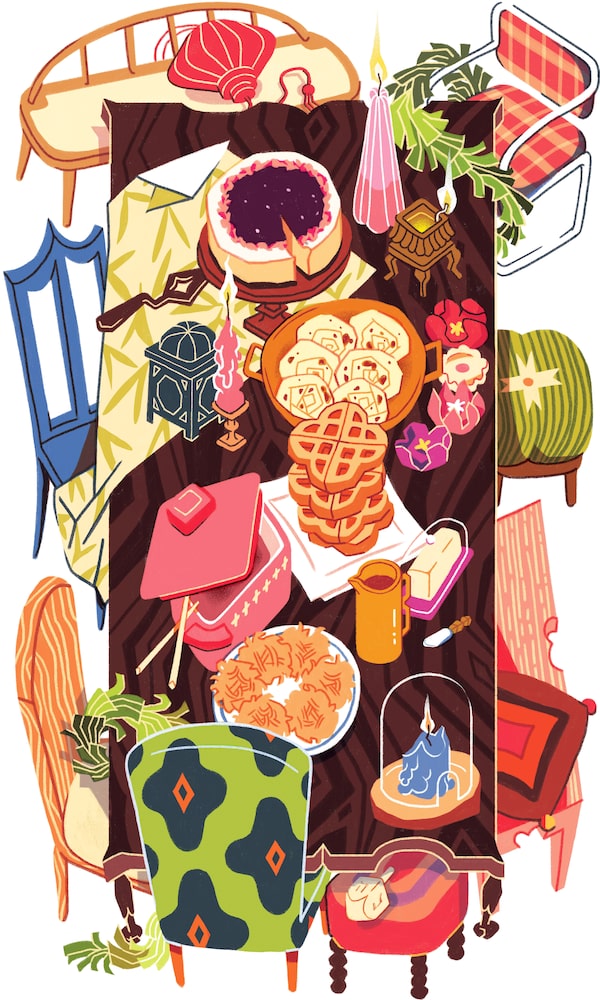
Illustration by Wenting Li
Plan your weekend with our Good Taste newsletter, offering wine advice and reviews, recipes, restaurant news and more. Sign up today.
Though December is often referred to as holiday season in this country, Canadians celebrate significant cultural and religious occasions throughout the year. The meals associated with these holidays draw friends and families together around tables and feed our sense of nostalgia. The Globe asked a diverse group of Canadians to share one of the dishes their festivities would not be the same without. (Note: The dates in this article have been updated since its original publication.)
Hanukkah
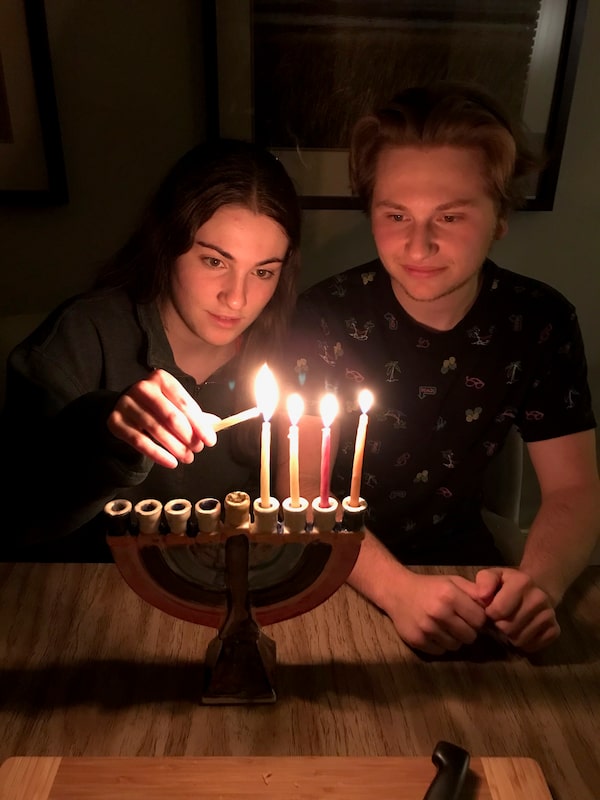
Julia Rosenblum and her brother, Adam, light a candle on a menorah.Julia Rosenblum/Handout
Dec. 7 to 15, 2023
Hanukkah is really about being with family, says Julia Rosenblum, who lives in Calgary with her parents, Melanie and Jeff, and brother Adam. When they lived in Toronto, they hosted their extended family. “We had a pretty small house so it was quite cramped and the entire place smelled of oil,” she says, “a smell that is now nostalgic for me.” Julia’s dad would make latkes for the family, following direction from his grandmother, who would top hers with a sprinkle of sugar. “It was pretty much just ‘Add some potatoes, onions, flour, eggs and some salt,’” Rosenblum says, “so we’ve had to improvise a little. But she did pass down her technique of making the latkes very thin and crispy.”
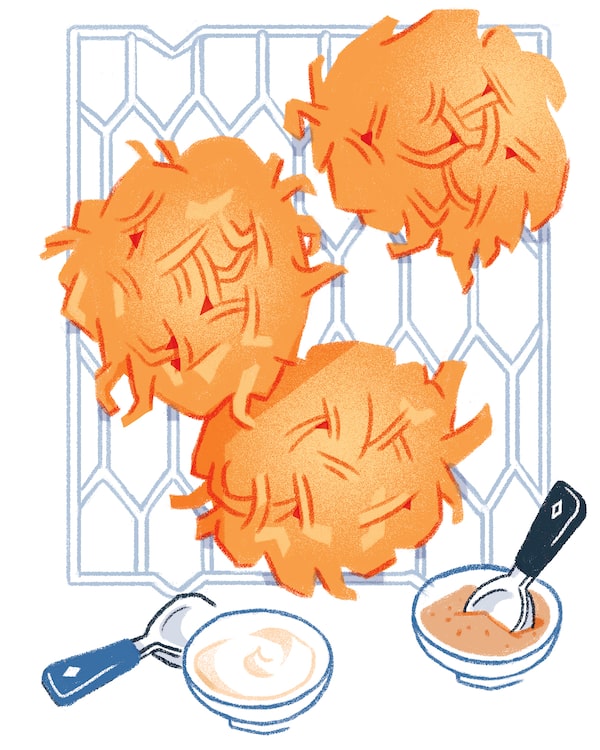
Illustration by Wenting Li
The Rosenblum Family’s Latkes
Ingredients (makes about 2 dozen)
- 2 pounds Yukon Gold potatoes
- 1 onion, minced
- 3 eggs, lightly beaten with a fork
- 1/4 cup flour or matzah meal
- 1 tablespoon oil, plus extra for frying
- 2 teaspoons baking powder
- 1-2 teaspoons curry powder (optional)
- 1 teaspoon salt
- Applesauce and sour cream, for serving
Grate the potatoes on the coarse side of a box grater onto a clean tea towel or double thickness of paper towel, and squeeze out as much moisture as possible. Put the grated potatoes into a large bowl, add the remaining ingredients and toss to combine everything well.
Set a heavy skillet over medium-high heat, add a generous drizzle of oil and add spoonfuls of the potato mixture to the pan, pressing them down to make thin latkes. Cook until deep golden and crisp on the bottom, then flip and cook until crisp and golden on the other side. Transfer to a paper towel-lined plate to drain excess oil.
Serve warm, topped with applesauce and/or sour cream.
Christmas

Greg Fraser and Darcy Lundgren's Christmas morning tradition is making waffles topped with butter and maple syrup, and a side of eggs and bacon.Handout
Dec. 25, 2023
Every Christmas morning, Greg Fraser and Darcy Lundgren open their gifts, then mix up a batch of waffles based on a recipe from an old, well-splattered Five Roses Cookbook. Fraser’s mom usually joins them in the morning for waffles topped with butter and maple syrup, and a side of eggs and bacon, and they enjoy breakfast in their art-filled Calgary loft, which doubles as showroom and design studio. Later in the day they head out to her house, an old converted church in Trochu, a small town in central Alberta, for a more elaborate dinner with family and friends – up to 52 guests pre-pandemic.
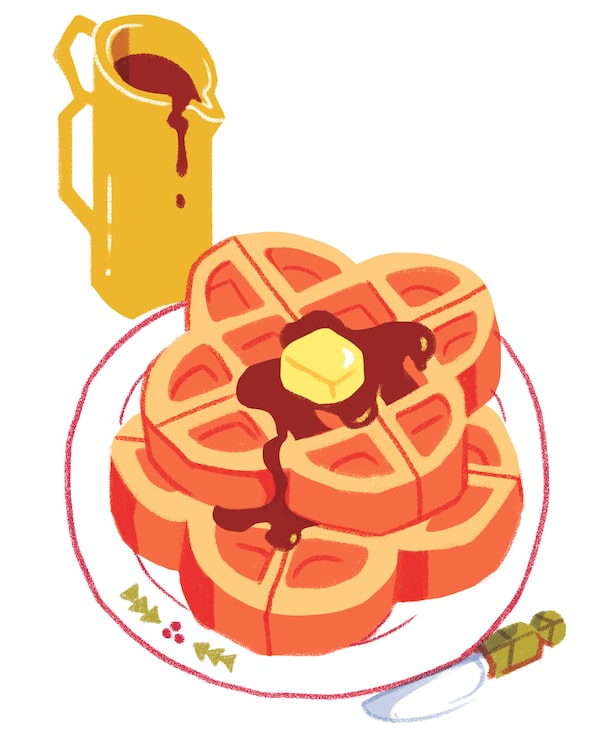
Illustration by Wenting Li
Darcy and Greg’s Christmas Morning Waffles
Ingredients (serves 2-4)
- 1 1/4 cups all-purpose flour
- 1 tablespoon sugar
- 2 teaspoons baking powder
- 1/2 teaspoon salt
- 1 1/4 cups milk (they use almond milk)
- 4 tablespoons vegetable oil
- 2 egg yolks, lightly beaten
- 2 egg whites
In a large bowl, combine flour, sugar, baking powder and salt. In another bowl (or measuring cup), whisk together the milk, oil and egg yolks. Add to the dry ingredients and stir just until blended.
In a clean bowl, beat the egg whites until stiff but not dry; fold into the batter. Cook in a preheated waffle iron according to the manufacturer’s directions. Serve immediately, with butter and maple syrup or your choice of toppings.
Lunar New Year

Van Thi Kim Pham with four of her children: Phuong, Tim, Victor and Kaylea, and Phuong’s children.Handout
Feb. 10, 2024
Van Kim Thi Pham and her family celebrate Tet, Vietnamese Lunar New Year, which her eldest daughter, Phuong, describes as the most significant celebration welcoming the new year and the arrival of spring. Phuong and her four siblings agreed that at home, their favourite Tet dish is thit kho tau, caramelized pork belly with egg, which their mom says brings good luck and joy for the new year. “The biggest thing, of course, was making food, traditional meals and foods like the thit kho, banh chung, gio cha, melon seeds, mut, et cetera,” Phuong says. “But this dish is definitely our family recipe – as soon as you smell it, it automatically means home, family and my mom.”
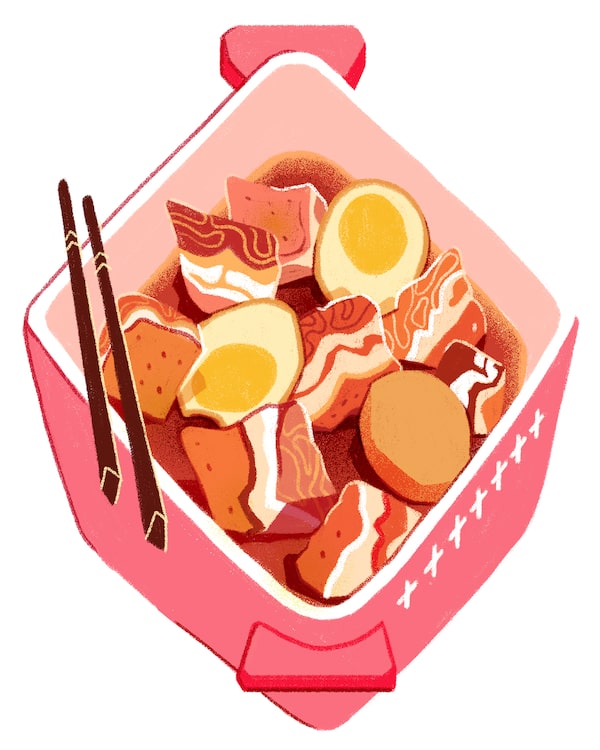
Illustration by Wenting Li
Van Kim Thi Pham’s Thit Kho Tau (Caramelized Pork and Eggs)
Ingredient (serves 4-6)
- 2 pounds pork belly, cubed into 1-inch pieces
- 3 cloves garlic, minced
- 1 shallot, minced
- 1 teaspoon salt
- 2 1/2 tablespoons granulated sugar
- 1/2 cup fish sauce (or more or less, to your taste)
- 6 hard boiled eggs, peeled
- 1 tablespoon vegetable oil
- 2 tablespoons dark mushroom flavoured soy sauce
- 3 cups chicken or pork bone stock
- 1 1/2 cups coconut water
- 1 teaspoon coarse fresh cracked black pepper
- Green onion, crispy garlic, peanuts or cilantro, for garnish (optional)
In a large pot, bring 3 litres of water to a boil. Cube pork belly into rough 1-inch cubes, add to water and blanch for two minutes. Remove from the water with a slotted spoon and add half of the minced garlic and shallot to the pork. Sprinkle with salt and let it cool and marinate for 30 minutes.
In a clean pot set over medium-low heat, combine the sugar and fish sauce. Cook gently until a caramelized amber colour, and add the hard boiled eggs. Stir gently until evenly coated and remove from heat. Remove eggs and add pork; toss to coat in the rest of the caramelized sauce/liquid. Remove everything and set aside.
In the same pot, add oil and the remaining garlic and shallot. Cook on low heat until soft and fragrant. Return the pork to the pot, gently stir, and then add the eggs, soy sauce, stock, coconut water and black pepper. Simmer on low heat for 1 to 1 1/2 hours, until tender.
Once finished, you may want to skim some fat off the top as this dish will produce a lot. Season to taste, and serve with fresh hot rice. Like most stews, flavours will mingle and be much better the next day. If cooled overnight, the fat will solidify at the top and it will be easier to remove excess before reheating. If you like, garnish with green onion, crispy garlic, peanuts or cilantro.
Eid
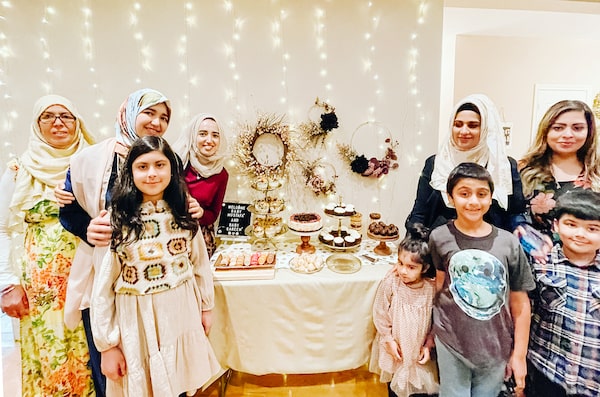
Mariam Munawar serves her Rosewater and Wild Blueberry Cheesecake with family and friends.Handout
Approximately April 9, 2024
Mariam Munawar’s cheesecake is a family favourite during Eid, which wraps up the month-long observance of Ramadan. Built on a basic cheesecake recipe her mom has been using since Miriam was a child, the flavour combination came to be when she drew on ingredients from her freezer and pantry instead of making a trip to the grocery store. She calls the result a true East meets West fusion. “The subtle essence of rosewater, which is heavily used in South Asian desserts, delicately complements the wild Canadian blueberries in a unique and festive way,” she says. The cake is now tradition at their celebrations in Toronto. With her South Asian family and Moroccan and Hungarian sisters-in-law, she says, their gatherings are bursting with different flavours.
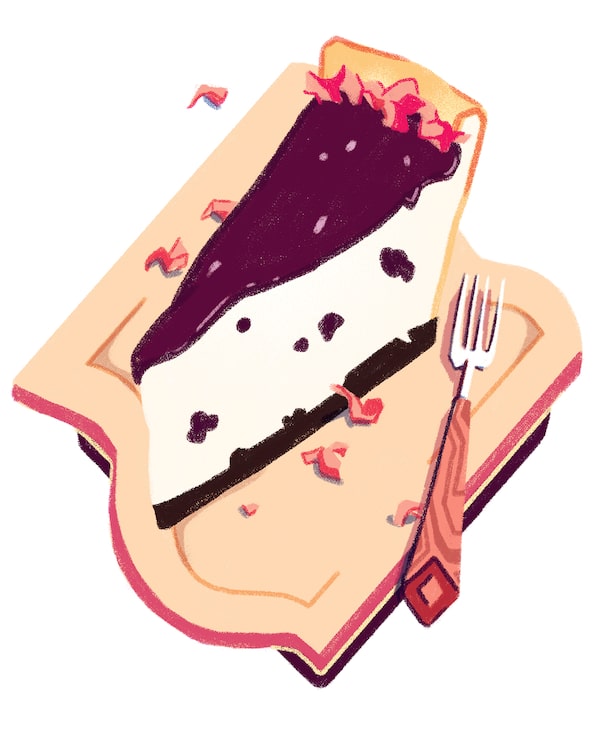
Illustration by Wenting Li
Mariam Munawar’s Rosewater and Wild Blueberry Cheesecake on a Chocolate Biscuit
Ingredients (serves 12)
Crust
- 1 1/2 cups chocolate biscuit crumbs (such as Oreo)
- 1/3 cup melted butter
Filling
- 4-8 ounces (250 grams) packages cream cheese
- 1 cup plus 2 tablespoons sugar
- 1 tablespoon cornstarch
- 1/4 teaspoon salt
- 2 cups sour cream
- 1/4 cup heavy whipping cream
- 4 eggs
- 4 tablespoons rosewater
- 2 tablespoons dry rose petals, plus extra for garnish (optional)
Blueberry sauce
- 2 cups blueberries, fresh or frozen
- 1/4 cup sugar
- 1/4 cup water
- 1 1/2 tablespoons lemon juice
- 1 tablespoon rosewater
- 2 tablespoons cornstarch
Preheat the oven to 325 F.
To make the crust, combine the chocolate crumbs and butter and press into the bottom of a 9-inch springform pan.
In a large bowl, beat the cream cheese, 1 cup of the sugar, the cornstarch and salt on medium speed using a handheld or stand mixer until well blended. Beat in 1 cup of the sour cream, the whipping cream and 4 tablespoons rosewater until blended well, using a spatula to scrape down the sides as needed.
Beat in the eggs one at a time, beating on low speed just until each is incorporated. Fold in the dried rose petals, if you’re using them, and pour over the crust.
Bake for 50 minutes, or until the middle is almost set. Stir 2 tablespoons sugar into the remaining 1 cup sour cream. Spread carefully over the cheesecake and bake an additional 10 minutes.
Remove the cheesecake from the oven, let it cool completely, then refrigerate for at least 8 hours, until set.
To make the sauce, combine the blueberries, sugar, water, lemon juice and rosewater in a saucepan over medium-high heat. Bring to a boil, then reduce heat to a simmer. Stir the 2 tablespoons of cornstarch into 2 tablespoons water and add to the sauce; continue to simmer until thickened, then set aside to cool completely.
When the cheesecake is well chilled, pour the blueberry sauce over the top, leaving some room around the outer edge. Carefully garnish with dry rose petals around the outer edge.
Diwali
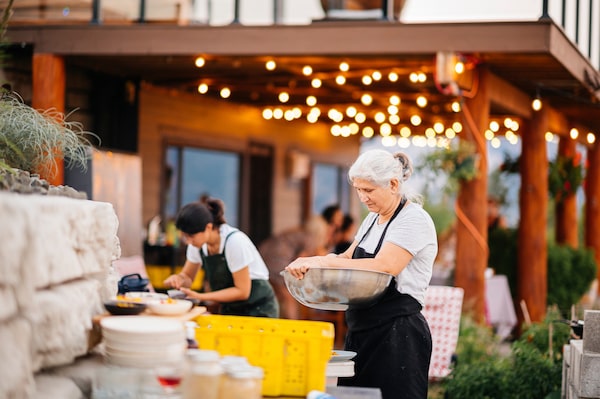
Jas Dosanj makes Malabar Paratha to celebrate Diwali with her family.Dong Kim/Handout
Oct. 31, 2024
On Diwali, a celebration spread over five days that’s widely known as the festival of lights, the Dosanj family in Kelowna, B.C., typically visits the temple, where they connect with friends and extended family, and eat. “Though a simpler chapati roti is more widely used at the temple because there are less steps, this paratha would be busted out for special occasions or in people’s homes,” Aman, the middle of three siblings, says of her mom’s flatbreads, which are often served with vegetarian dishes such as black daal or choleh, the Punjabi word for channa masala. Jas also makes kheer, a creamy, cardamom-scented rice pudding, for occasions such as Diwali. “Anything sweet is good for prosperity,” Aman says. Back at home, they light candles to “mark the new year with a little love and light.”
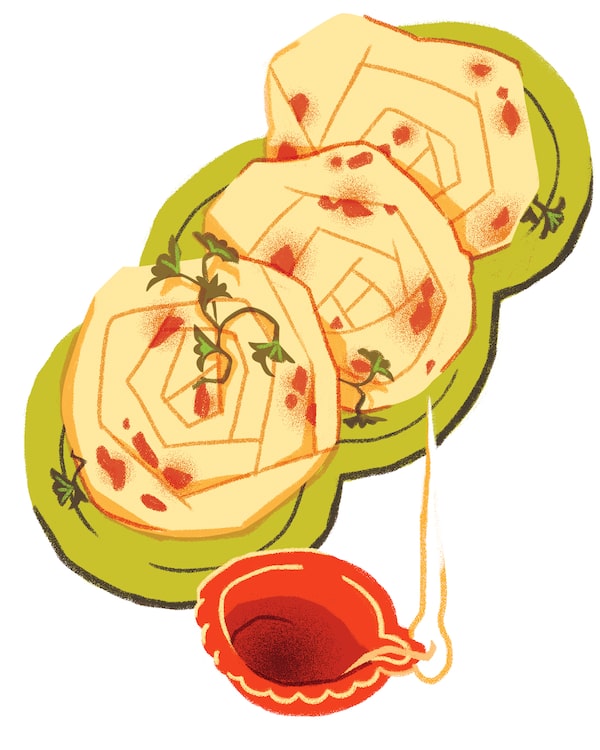
Illustration by Wenting Li
Jas Dosanj’s Malabar Paratha
Ingredients (makes 4 paratha)
- 1 cup organic all-purpose flour, plus extra for dusting and rolling
- 1 cup organic whole wheat flour
- 1 tablespoon organic cane sugar
- 1/2 teaspoon salt
- 1 tablespoon unsalted butter, melted
- 3/4 cup warm water (approximately, you may need more or less depending on your flour and humidity where you live)
- Vegetable oil for the dough and cooking
Put the flours into a large mixing bowl and add the sugar and salt. Rub in the melted butter, then gradually add the warm water until the dough comes together and you can form a ball.
Knead until soft. The dough will be sticky. Add a few drops of oil and briefly knead once more. Cover and let rest for 30 minutes; this will prevent the dough springing back when rolling and will make flaky paratha.
Knead again with a drizzle of oil. You’ll notice the dough is soft and smooth this time. As you knead, push the dough away from you to activate the gluten.
Divide the dough into 4 equally sized balls. Flatten each into a patty, dip both sides into a shallow bowl of flour, and roll out as thin as you can – about 10 inches. (Don’t worry if the dough rips or there are holes at this stage.)
With your fingers, smear oil over the dough (about 1-2 teaspoons for each paratha), then lightly dust with flour. Starting from one side, pleat the dough, folding it accordion-style to form layers, stretching outwards as you go. Coil it up like a cinnamon bun, tucking any loose bits underneath. (This can be done ahead of time; cover with plastic wrap to stop the dough from drying out.)
Once all the balls have been shaped, heat a tava or flat skillet over medium heat. One at a time, flatten the coiled dough, then roll out in a thin, even round shape again. Drizzle some oil into your heated tava, and rub it all over the surface with paper towel. Place the paratha on the skillet and cook, flipping twice, smearing with oil each time. It will start to brown and become crispy.
Once cooked (another two or so flips until it’s crispy), place the paratha on your countertop and when it’s cool enough to handle, squash using both your hands to separate the layers, or pick it up and clap your hands together with the paratha between them. Dust off your tava to remove any excess flour, then repeat for the remaining parathas. Eat straight away.